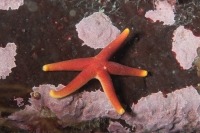
(Photo: Claire Goodwin)
Blood Star
Henricia sanguinolenta
Individuals have five arms. They are often deep red, leading to the name of blood star, yet they can also be purple, lavender, orange, or yellow. The disc (the centre of the body that connects the arms) grows to a diameter of 10 to 20 centimetres. The arms taper to the tips, with the underside of each containing a groove lined with tube feet. The top feels like sandpaper to the touch.
Authority
O.F. Muller, 1776
Classification Details
Phylum: Echinodermata (echinoderms); Class: Asteroidea (sea stars).
Habitat
Common on both sides of the northern Atlantic Ocean, the Arctic, and the northeastern Pacific. Generally prefer rocky habitats, or rock and sand. It lives from shallow subtidal waters down to 1 000 metres or more. Often found amongst sponges.
Diet
Planktivores and carnivores. Use passive filter-feeding to eat small food particles in the water. Passive filter feeders use existing water currents rather than creating their own by movement. This species may take advantage of water currents created by sponges. They also feed on the tissues of sponges, tunicates, and other invertebrates. They eat at least 12 species of sponges, preferring finger sponges in the genus Isodyctia. Blood stars can evert their stomach (turn their stomach inside-out) to engulf large prey items.
Reproduction
Sexes are separate. Egg fertilization is external. Females lay 100 to 1 000 eggs on the ocean floor, then stay over them for three weeks. During this time, they do not eat. They cover their eggs in a sticky mucous that holds them together. This is one of the few sea stars that broods its eggs, and whose young does not have a free-swimming larval stage. Larval blood stars stay enclosed under their mother's arms until they can survive on their own. They live two to five years, but sexual maturity is dependent on size rather than age. They reach sexual maturity at 18 millimetres in size or above.
Fun Facts
More than 90% of blood stars in Europe are hosts to the parasitic copepod Asterocheres lilljeborgi. This copepod is an ectoparasite - it lives on the skin of the sea stars. The body fluid of Forbes' sea star, Asterias forbesi, has a toxin that is fatal when injected into most other sea stars. But it does not have any effect on the blood star.
Blood stars have two stomachs: the cardiac stomach and the pyloric stomach. They evert their cardiac stomach through their mouth to engulf their prey. They then transfer the prey to the pyloric stomach where it is digested.
References
Guedry S (2003) Henricia sanguinolenta. Animal Diversity Web. https://animaldiversity.org/accounts/Henricia_sanguinolenta/ Accessed online 20 January 2020. Jackson A (2008) Henricia oculata Bloody Henry starfish. In Tyler–Walters H. and Hiscock K. (eds) Marine Life Information Network: Biology and Sensitivity Key Information Reviews, [on–line]. Plymouth: Marine Biological Association of the United Kingdom. [cited 26–01–2020]. Available from: https://www.marlin.ac.uk/species/detail/1131 Accessed online 20 January 2020. Palomares MLD and Pauly D (2019) Sealife Base. Henricia sanguinolenta (Müller, 1776) blood sea star. https://www.sealifebase.ca/summary/Henricia-sanguinolenta.html Accessed online 20 January 2020. Sheild CJ and Witman JD (1993) The impact of Henricia sanguinolenta (O.F. Müller) (Echinodermata:Asteroidea) predation on the finger sponges, Isodictya spp. Journal of Experimental Marine Biology and Ecology 166, 107–133.

